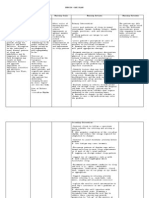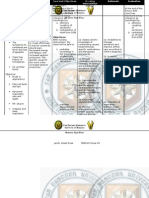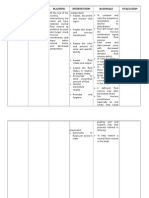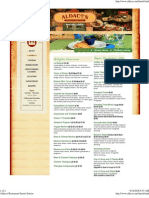NCP Final
NCP Final
Uploaded by
Jessica MedinaCopyright:
Available Formats
NCP Final
NCP Final
Uploaded by
Jessica MedinaOriginal Title
Copyright
Available Formats
Share this document
Did you find this document useful?
Is this content inappropriate?
Copyright:
Available Formats
NCP Final
NCP Final
Uploaded by
Jessica MedinaCopyright:
Available Formats
CHAPTER 8 NURSING CARE PLAN
ASSESSMENT SUBJECTIVE: Nganong perme ko malipung as verbalized by the pt.
DIAGNO SIS Risk for prone behavior r/t lack of knowledge about the disease.
OBJECTIVE: -request information -agitated behavior -inaccurate follow through of instructions. -VS taken as follow T: 38.4 P: 105 R: 23 BP: 160/100
PLANNING After 4 hours of nursing intervention patient will verbalized understanding of disease, process and treatment regimen.
INTERVENTION >Defined and stated the limits of desired BP, explain hypertension and its effect on the heart, blood vessels, kidney and brain.
>Assisted the patient in identifying modifiable risk factors like high sodium diet, saturated fats and cholesterol. >Reinforced the importance of adhering the treatment regimen and keeping follow up appointment.
RATIONALE >Provides bases for understanding elevations of Blood pressure, and clarifies misconceptions and also understanding that BP can exist without symptoms or even when feeling well. >These risk factors have been shown to contribute to hypertention.
EVALUATION Goal met -After 4 hours of nursing intervention the patient was able to verbalized understanding of the disease process & treatment regimen.
>Lack of cooperation is common reason for failure of anti hypertensive
>Suggest frequent position changes, leg exercises when lying down.
therapy.
>Help patient identify sources of sodium intake.
>Decrease peripheral venous pooling that maybe potentiated by vasodilators and prolonged sitting or standing. >Two years of moderate low salt diet maybe be sufficient to control hypertension. >Caffeine is a cardiac stimulant and adversely affect cardiac function. >Alternating rest inactivity increases tolerance to activity progression.
>encouraged patient to decrease on eliminate caffeine like in tea , coffee, cola and chocolates. >Stressed importance of accomplishing daily rest periods.
DEPENDENT: >Provide information regarding community resources and
support patients >Community in making lifestyle resources like changes. health center programs and check ups are helpful in controlling hypertension.
ASSESSMENT SUBJECTIVE: - wala pako naka libang sugad ganina buntag
DIAGNOSIS constipation related to voiding incontinence.
PLANNING After 4 hrs of nursing intervention, the patient will verbalize understanding the etiology and
INTERVENTION - Educate patient/
RATIONALE - Information can
EVALUATION Goal Met the patient verbalized understanding about constipation and gained knowledge of appropriate intervention.
SO about safe and help client to make risky practices for managing constipation. beneficial choices when need arises.
OJECTIVE: - Decreased
appropriate intervention if constipation
- Instruct balance fiber and bulk in diet and fiber supplements.
- To improve consistency of stool and facilitate passage through colon.
ambulation of may occur. the patient bcs of pain and the complete bed rest ordered of the physician.
- Promote adequate fluid intake, also - To promote soft stool and stimulate
suggest drinking warm fluids.
bowel activity.
- Encourage activity within limits of individual ability.
-To stimulate constrictions of the intestines
ASSESSMENT SUBJECTIVE: murag nagabug`at man ang akong timbang as verbalized by the patient.
DIAGNOSIS Decreased cardiac output r/t decreased venous return
OBJECTIVE: -variations in BP -edema -VS taken as follows T: 37.5 P: 87 R: 22 BP:120/100
PLANNING After 6 hours of nursing intervention the patient will participate in activities that reduce blood pressure or cardiac work load.
INTERVENTION INDEPENDENT: >Monitor blood pressure of the pt. Measure in both arms or thigh three time, 3-5 minutes apart while pt is at rest, then standing for initial evaluation. >Observe, skin, color, moisture, temperature & capillary time
RATIONALE >Comparison of pressures a more complete picture of vascular involvement or scope of the problem.
>Note dependent or general edema >provide calm, rest full surroundings, minimize environmental activity or noise. >Maintain activity restrictions
>Presence of pallor, cool, moist skin, & delayed capillary refill time maybe due to peripheral vasoconstriction >May indicate heart failure renal or vascular impairment. >Help reduce sympathetic stimulation, promotes relaxation >Reduces physical stress & tension that affect blood pressure & course of
EVALUATION Goal met After 6 hours of nursing intervention the patient was able to participate in activities that reduce blood pressure or cardiac workload.
>Instruct in relaxation &
guided imagery.
DEPENDENT: >Implement dietary sodium, fat, & cholesterol restrictions as indicated
hypertension >Can reduce stressful stimuli produce calming effect, thereby reduce blood pressure. >These restrictions can help manage fluid retention & with associated hypertensive response, which decrease cardiac workload.
ASSESSMENT Subjective: Luya kaayo akong paminaw. Maski sige lang ko ug tulog kay kapoie gihapon akong ginabati as verbalized by the patient.
DIAGNOSIS Fatigue related to poor physical condition
PLANNING At the end of 1 day span of nursing care, the patient will be able to:- report improved sense of energyperform ADLsparticipate in desired activities
INTERVENTION 1. Teach energy conservation principles.
RATIONALE 1.Patients and care giver may need to learn skills for delegating tasks to
EVALUATION At the end of 1 day span of nursing gcare, the patient was able to:-
others, setting priorities Report improved and clustering care to sense of use available energy to energyArangcomplete desired activities. arang na akong paminawas verbalized by 2.Stress the importance of 2. Energy reserves may be depleted unless the patient respects the body need for increased rest. patient.
Objective:
at level of ability
=Weakness =Lack of energy =Pale skin =Decreased muscle strength
frequent rest periods
3. Observe the patient usual level
3. Both increased physical exertion and
of exercise and physical activity.
limited levels of exercise can contribute to fatigue.
4. Assist the patient to develop a schedule for daily activity and rest.
4. A plan that balances periods of activity with periods of rest can help the patient complete desired activities without adding to levels of fatigue.
ASSESSMENT Subjective: Sakit kaayo ang akong tiyan sa bandang baba as verbalized by the patient.
DIAGNOSIS Acute pain r/t to epigastric pain
PLANNING After 2hrs. span of care patient pain will be relief or
INTERVENTION 1.observed and document location of the pain, scale(010) and character of
RATIONALE 1.Provide information about disease progression, development of complication and
EVALUATION After 2hrs. span of care patient pain was relief and controlled as the evidence of pain scale of 3 out of 10.
controlled as the pain. evidence of pain scale 7 out of 2.Promote bed rest.
effectiveness of intervention
Objective:
10. 3.Encourage of use
=Grimaced face noted =Narrowed focus guarding behaviour =pain scale of 7 out of 10.
relaxation techniques. 2.To reduce intraabdominal pressure 4.Control environmental pressure. 3.To promote rest ,redirect attention, may enhance 5.Administered medication as physician ordered. 4.To minimize dermal discomfort. coping.
5.To reduce severe pain, promotes and relax smooth muscle.
ASSESSMENT Subjective: Naga luya ko pero dali lang kaayo ko kapuyon as verbalized by the patient.
DIAGNOSIS Risk for Activity
PLANNNING After 8hrs of
INTERVENTION Assess patients ability to perform normal task or activities of daily living.
RATIONALE Influences choice of interventions or needed assistance
EVALUATION After 8hrs of nursing intervention the patient was able to reveals an
in Tolerance r/ t nursing body weakness intervention the patient will Report an increase an activity in tolerance
May indicate Note changes in balance/ gait disturbance, neurological changes associated with vitamin B12deficiency, affecting patient safety or risk of injury.
increase inactivity tolerance.
Objective: =Body malaise noted = look tired =pale skin noted =With fatigability
including
activities of daily muscle weakness. living.
Recommend quiet atmosphere, bed rest if indicated.
Enhances rest to lower bodys oxygen requirements, and reduces strain on the heart and lung
Elevate the head of the bed as tolerated.
Enhances lung expansion to maximize oxygenation for cellular uptake.
Provide or recommend assistance with activities or ambulation as necessary, allowing patient to do as much as possible
Although help maybe necessary, self esteem is enhanced when patient does some things for self.
ASSESSMENT SUBJECTIVE: Init kayo kayo dire ma`am sabah pa jud as verbalized OBJECTIVE: >irritability >elevated blood pressure >VS taken as follow T: 38.4 P: R: BP:140/90
DIAGNOSIS Risk for seizure r/t environmental factor & stressor
PLANNING After 1 hour of nursing intervention the patient will able to understand the risk factor of seizure.
INTERVENTION >Encouraged verbalization of feelings & perception regarding her present Condition. >Educate client regarding risk factors of seizure >Determined factors r/t individual situation, as listed in risk factor, & extent of risk. >Assess influence of clients lifestyle & stress on potential for seizure. >Reviewed diagnostic studies & laboratory test for imbalances. >provided seizure precaution. >Kept bed in low position as appropriate. >Encouraged
RATIONALE >To assess the knowledge of the patient regarding her present condition. >Able to demonstrate understanding for her benefit. >Influences scope and of interventions to manage threat to safety.
EVALUATION Goal Met The patient demonstrate and able to verbalize understanding regarding the risk or the factors that may lead to seizure.
>That may result in or exacerbate conditions.
>to prevent injury or fall if seizure
divertional activities such as chatting to other patient`s. >provided comfort.
occur. >To divert her attention and lessen stressors.
>for patients comfort
ASSESSMENT SUBJECTIVE: wala ko kaihi sukad gahapon
DIAGNOSIS Impaired urinary elimination
OBJECTIVE: - low urine output for 8 hours 100cc - with foly catheter - edema Urinalysis: Color: Light Yellow Appearance: Clear Reaction: 8 Specific gravity: 1.05 PUS CELL: 0-5 Sugar: (-) Albumin: (+) Protein: +3 (0.5g)
PLANNING After 4 hours of nursing intervention the patient will achieve normal urine elimination pattern or participate in measure to correct or compensate for deffects.
INTERVENTION >Determined client usual daily fluid intake. Note condition of skin in mucus membranes, color of urine. >Ascertain clients previous pattern of elimination. >Have client keep a voiding dairy for 3 days to record fluid intake, voiding times, precise urine output, in dietary intake. >Encourage fluid intake up to 3000cc or more per day, including cranberry juice.
RATIONALE >To help determined level of dehydration.
EVALUATION Goal Partially Met The patient was able to compensate but normal urine elimination pattern was not achieved.
>For comparison with current situation. >helps determined baseline symptoms, severity of frequency or urgency, in whether diet is a factor. >To help maintain renal function, prevent infection and formation of urinary stones, avoid encrustation around catheter, or flushing urinary diversion appliance.
>Check frequently for
bladder distention and observe for overflow
To reduce risk of infection and/or automatic hyperrelfexia.
Assessment Subjective: nagainit akoang lawas, mura man kug gi hilantan oi, kapoy pa gyud mu lihok As verbalized by the patient Objective: Dry skin Warm to touch Dry lips Irritable Temp: 38.4
Nursing Diagnosis Hyperthermia related to invasion of infection.
Planning After 4 hours of completing the nursing intervention, the patients body temperature must fall within the normal range of 37.4
Intervention Independent: Establish Rapport Health teaching to the watcher regarding the proper way of taking care of the patient while on hyperthermia Apply TSB Promote surface cooling by loosening the clothes Assess fluid loss and facilitates oral fluid intake to accomplish fluid replacement
Rationale To gain trust
Evaluation
After 2 days of performing intervention, goal was partially met, To educate and the watcher has supply gained information knowledge about hyperthermia and the patients body Promote heat loss temperature by evaporation decreased from and conduction 38.4 to 37.4 Increase metabolic rate and diaphoresis associated with fever
Dependent: Administer Paracetamol as prescribed. Medicine to reconcile rise of temperature.
You might also like
- Assessment Needs Nursing Diagnos IS Goal/Obj Ective Intervention Rationale EvaluationDocument10 pagesAssessment Needs Nursing Diagnos IS Goal/Obj Ective Intervention Rationale EvaluationApol Pen67% (3)
- Nursing Care PlanDocument11 pagesNursing Care PlanKevin John ReaLubit SaLisi100% (6)
- Blood: Prepared by Patty Bostwick-Taylor, Florence-Darlington Technical CollegeDocument63 pagesBlood: Prepared by Patty Bostwick-Taylor, Florence-Darlington Technical Collegedomo domoNo ratings yet
- Nursing Care PlanDocument3 pagesNursing Care PlanCristina L. JaysonNo ratings yet
- NURSING CARE PLAN For Nsg. Research Betty NeumannDocument9 pagesNURSING CARE PLAN For Nsg. Research Betty NeumannFlor SabaysabayNo ratings yet
- NCPDocument13 pagesNCPLee Da HaeNo ratings yet
- NCP Activity IntoleranceDocument4 pagesNCP Activity IntoleranceKryza Dale Bunado Batican0% (1)
- The Ride of Your Life: What I Learned about God, Love, and Adventure by Teaching My Son to Ride a BikeFrom EverandThe Ride of Your Life: What I Learned about God, Love, and Adventure by Teaching My Son to Ride a BikeRating: 4.5 out of 5 stars4.5/5 (2)
- Ventricular Septal Defect, A Simple Guide To The Condition, Treatment And Related ConditionsFrom EverandVentricular Septal Defect, A Simple Guide To The Condition, Treatment And Related ConditionsNo ratings yet
- COMPREHENSIVE NURSING ACHIEVEMENT TEST (RN): Passbooks Study GuideFrom EverandCOMPREHENSIVE NURSING ACHIEVEMENT TEST (RN): Passbooks Study GuideNo ratings yet
- NCPDocument7 pagesNCPBeverLyNo ratings yet
- Nursing Care PlanDocument9 pagesNursing Care PlanjmichaelaNo ratings yet
- NCPDocument17 pagesNCPShayne Jessemae AlmarioNo ratings yet
- Myocardial InfarctionDocument5 pagesMyocardial InfarctionDharline Abbygale Garvida AgullanaNo ratings yet
- NCPDocument8 pagesNCPJose Benit DelacruzNo ratings yet
- Cues Nursing Diagnosis Scientific Reason Planning Intervention Rationale EvaluationDocument6 pagesCues Nursing Diagnosis Scientific Reason Planning Intervention Rationale EvaluationKatrina Ponce86% (7)
- NCP GrandcaseDocument5 pagesNCP GrandcaseSaima BataloNo ratings yet
- Nursing Care PlanDocument10 pagesNursing Care PlanGinel Laquiores100% (1)
- NCP CKDDocument9 pagesNCP CKDDanica Salinas100% (1)
- 4 NCP's FinalDocument9 pages4 NCP's FinalZenel Yap100% (1)
- Ncps TetanyDocument18 pagesNcps TetanyBob Joyce Dela PeñaNo ratings yet
- NCP Hypertension 2Document3 pagesNCP Hypertension 2Roseben Somido50% (2)
- NCPDocument10 pagesNCPannamargie07No ratings yet
- Assessment Diagnosis Planning Intervention Rationale EvaluationDocument10 pagesAssessment Diagnosis Planning Intervention Rationale EvaluationLean Ashly Tuddao Macarubbo0% (1)
- Nursing Care Plan (CASE STUDY DENGUE)Document10 pagesNursing Care Plan (CASE STUDY DENGUE)NiooleNo ratings yet
- NCP For CipDocument22 pagesNCP For CipBing DayaoNo ratings yet
- Nursing Care PlanDocument23 pagesNursing Care PlanLorielle HernandezNo ratings yet
- NCP (Fatigue)Document1 pageNCP (Fatigue)student_019100% (1)
- GastroenteritisDocument8 pagesGastroenteritistanlimdania100% (3)
- NCPDocument12 pagesNCPJonathan Liscano100% (3)
- NCP FinalDocument7 pagesNCP FinalAkira MizukamiNo ratings yet
- NCPDocument10 pagesNCPNefre Dayap DarrocaNo ratings yet
- NCP Copd4Document15 pagesNCP Copd4Alessa Marie Crisostomo Salazar100% (1)
- Concept Map - Abby !Document3 pagesConcept Map - Abby !Franklin A. Salaum III0% (2)
- Nursing Care Plan Problem: Difficulty of BreathingDocument5 pagesNursing Care Plan Problem: Difficulty of BreathingIvan Louise Fajardo ManiquizNo ratings yet
- Nursing Care PlansDocument10 pagesNursing Care PlansClaire Alcantara50% (2)
- NCPDocument6 pagesNCPSarah Younes AtawnehNo ratings yet
- NCPDocument7 pagesNCPAbbie TantengcoNo ratings yet
- Nursing Management of CVA and NIDDMDocument12 pagesNursing Management of CVA and NIDDMKaloy KamaoNo ratings yet
- Discharge Planning and NCP'sDocument8 pagesDischarge Planning and NCP'sYvonne Niña Aranton75% (4)
- Nursing Care Plan - MergedDocument13 pagesNursing Care Plan - MergedJuls Flares SycaycoNo ratings yet
- NCPDocument1 pageNCPAlynna ValbuenaNo ratings yet
- Chemo NCPDocument2 pagesChemo NCPJustin Eduardo100% (1)
- Drug Study and NCP!Document8 pagesDrug Study and NCP!Abegail Abaygar100% (1)
- NCPDocument9 pagesNCPLeolene Grace BautistaNo ratings yet
- NCP CP 3 IreneDocument3 pagesNCP CP 3 IreneKenNo ratings yet
- Nursing Care PlansDocument6 pagesNursing Care PlansTwobee Kriz LeghidNo ratings yet
- NCP MiDocument8 pagesNCP MiPitaca Madiam Annabehl PaulNo ratings yet
- NCP Activity IntoleranceDocument3 pagesNCP Activity Intolerancekeiii_21No ratings yet
- Nursing Care Plan: Name of Patient: A. Beltran DIAGNOSIS: NephrolithiasisDocument3 pagesNursing Care Plan: Name of Patient: A. Beltran DIAGNOSIS: NephrolithiasisienmaNo ratings yet
- 5ncp AnemiaDocument8 pages5ncp Anemiabeverly_domingoNo ratings yet
- Pott's Disease NCPDocument7 pagesPott's Disease NCPkristel_nicole18yahoNo ratings yet
- IUFDDocument13 pagesIUFDChristopher Lontoc0% (1)
- NCPDocument5 pagesNCPkimchi girl0% (1)
- 1) Nursing Careplan For FeverDocument9 pages1) Nursing Careplan For FeverY. Beatrice AbigailNo ratings yet
- NCPDocument4 pagesNCPAbegail Abaygar100% (1)
- NCP FinalDocument7 pagesNCP FinalRuss RussNo ratings yet
- Self Care DeficitDocument4 pagesSelf Care DeficitEllaine RamirezNo ratings yet
- NCLEX-RN Physiological Integrity Exam Prep :300 Practice Questions with Detailed Answers and Explanation to Master Your Exam: NCLEX-RN EXAM PREP:PRACTICE QUESTIONS AND ANSWERS, #4From EverandNCLEX-RN Physiological Integrity Exam Prep :300 Practice Questions with Detailed Answers and Explanation to Master Your Exam: NCLEX-RN EXAM PREP:PRACTICE QUESTIONS AND ANSWERS, #4No ratings yet
- NurcingDocument2 pagesNurcingJessica MedinaNo ratings yet
- Infection Control LectureDocument21 pagesInfection Control LectureJessica Medina100% (1)
- NCP 1Document1 pageNCP 1hsiriaNo ratings yet
- Predisposing Factor Precipitating Factor: PathophysiologyDocument3 pagesPredisposing Factor Precipitating Factor: PathophysiologyJessica MedinaNo ratings yet
- Lunch MenuDocument2 pagesLunch MenueatlocalmenusNo ratings yet
- Sanet - St-Introduction To Multiscale Mathematical ModelingDocument171 pagesSanet - St-Introduction To Multiscale Mathematical ModelingErmal SpahiuNo ratings yet
- Satish Reddy (M.S. Mechanical Engineering-1990) Receives Recognition For His Work at NASADocument1 pageSatish Reddy (M.S. Mechanical Engineering-1990) Receives Recognition For His Work at NASAjeansonNo ratings yet
- Bommai Budget SpeechDocument136 pagesBommai Budget SpeechPrajwal D'SouzaNo ratings yet
- Test Universe Advanced Differential Module Application Note Example of Use Transformer ENUDocument43 pagesTest Universe Advanced Differential Module Application Note Example of Use Transformer ENUMahmoud Shafie100% (1)
- Probability Theory Presentation 10Document51 pagesProbability Theory Presentation 10Xing QiuNo ratings yet
- Under The SeaDocument2 pagesUnder The SeaStuart DarlingNo ratings yet
- SC 2016 SE DC Licensing DatasheetDocument2 pagesSC 2016 SE DC Licensing DatasheetAmith PrasannaNo ratings yet
- Customized Meal Plan For Rapid Weight LossDocument3 pagesCustomized Meal Plan For Rapid Weight LossPramesh MallaNo ratings yet
- Inspection and Test Plan: ACTIVITY: ITP For Inspection of Embankment With Pond AshDocument1 pageInspection and Test Plan: ACTIVITY: ITP For Inspection of Embankment With Pond AshjitendraNo ratings yet
- Ultrasonic Sensor in Flow MeterDocument7 pagesUltrasonic Sensor in Flow MeterHemantkumarNo ratings yet
- 02b Static - Mixer - For - Water-E PDFDocument12 pages02b Static - Mixer - For - Water-E PDFkuaNo ratings yet
- Why ProgesteroneDocument13 pagesWhy ProgesteroneMika NovikovNo ratings yet
- NetworksDocument74 pagesNetworksIlesh DinyaNo ratings yet
- Preposotion NotesDocument19 pagesPreposotion NotesABHISHEK MISHRANo ratings yet
- Astm E739.18040Document7 pagesAstm E739.18040Arturo MendozaNo ratings yet
- Land TransportDocument26 pagesLand TransportAnnie Claire VisoriaNo ratings yet
- NICHOLS Et Al-1965-Journal of PhycologyDocument5 pagesNICHOLS Et Al-1965-Journal of PhycologymmmmmmmmxpNo ratings yet
- Vocal VisualiserDocument1 pageVocal VisualiserSatish PatelNo ratings yet
- SQ SQE BrochureDocument16 pagesSQ SQE BrochurepetarNo ratings yet
- Tecnam P2008 Emergency ChecklistDocument2 pagesTecnam P2008 Emergency ChecklistKoçak koçakNo ratings yet
- Firefighter 12 Week Fitness ProgrammeDocument13 pagesFirefighter 12 Week Fitness ProgrammecampschettyNo ratings yet
- J Engstruct 2007 07 008Document12 pagesJ Engstruct 2007 07 008Jaouad OuaâzizNo ratings yet
- Andarani2013 Indonesia Ewaste Potential PDFDocument15 pagesAndarani2013 Indonesia Ewaste Potential PDFcipta panghegarNo ratings yet
- Week 5Document6 pagesWeek 5Christine Cayosa100% (1)
- PorosityDocument19 pagesPorosityRoland EndrészNo ratings yet
- GovLab Jakarta Report 160902Document12 pagesGovLab Jakarta Report 160902Eni PurwantiNo ratings yet
- Impact of Traffic ThesisDocument62 pagesImpact of Traffic ThesisManny De MesaNo ratings yet
- MT880 User ManualDocument74 pagesMT880 User ManualsergioperrNo ratings yet





























































































